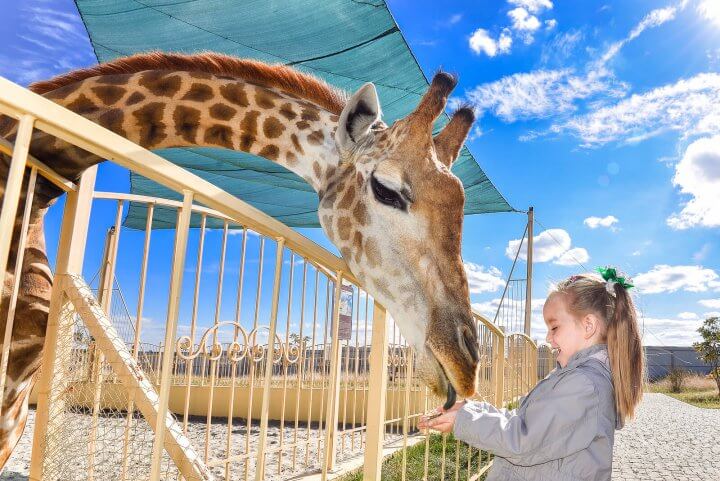One of the highlights of any zoo or wildlife park is the giraffes. These are fascinating animals that never fail to capture both the camera lens and the imagination of those who come to see them. The giraffe is an African mammal and is the tallest of all land-living animal species. Males can measure anywhere from sixteen to eighteen feet tall and weigh up to 3,000 pounds. The largest bull ever recorded was 19.2 feet tall and weighed approximately 4,400 lbs. Females are generally slightly shorter and weigh less than the males do. Giraffes tend to range naturally from Chad to South Africa. They were found in almost every region in the savannah that had trees but were eliminated from most of Western Africa due to illegal hunting. Even so they are still reasonably common and have not, as yet, been threatened with extinction.
The giraffe is both non territorial and sociable, and prefers living in loose, open herds. At any given moment a giraffe may be in a herd composed of all males, all females, females and young, or any other configuration. There are no leaders and there is minimum coordination of herd movements. The fluid nature of the giraffe society reflects the need to spend most of its time feeding. The giraffes tend to move independently between variably spaced trees, and their size makes it unnecessary to bunch together for mutual security. Also their height and having excellent eyesight enable giraffes to maintain visual contact at long distances, thus a dozen giraffes may be dispersed over a half mile of savannah and still be in a herd. In fact, giraffes tend to rarely cluster together unless they happen to be attracted to the same tree, nervous over the presence of lions, or aggregated in the open. Even when they are resting, herd members stay over twenty yards apart. Females are more sociable than males and are rarely out of sight of other females. Mothers of small calves associate the most consistently; this is due at least partly because of a mutual attraction between youngsters that results in crèches of up to nine calves. The average spacing between calves is usually less than ten yards apart. The male giraffes remain in maternal herds until they outgrow their resemblance to females at about three years old, after which they join bachelor herds.
Giraffes are able to reproduce year round with the rainy season being the peak time. They usually have their first pregnancy in the fourth year. Gestation is fourteen to fourteen and a half months. The minimum interval between calves is usually about sixteen months. Giraffes observe an age-based hierarchy that allows the alpha male to choose the fertile females without ever coming to blows like many other species.
A cow typically returns to the same location each time that she calves. The first week after a calf is born, it is most carefully guarded by its mother who usually stays within eleven to twenty-five yards of her offspring. The increased security is provided by the maternal group which watches over all the calves. Absent mothers usually always return before dark to suckle their new offspring and stay with them overnight. Even though giraffes are weaned as yearlings and are nutritionally independent by sixteen months old, the maternal bond lasts about twenty-two months.
About fifty to seventy-five percent of calves fall prey to predators in the first few months despite hiding and their mother’s determined defenses. As adults, giraffes become too big to be regular prey. Mother giraffes have been known to stand over their young offspring and defend them against lions that run the risk of being kicked to death if they get to close. Females never use their horns, and males only use theirs in contests with peers. Giraffes tend to live about twenty-five years in the wild and slightly more in captivity.


Leave a Reply